Preserving Houston’s LGBT History
How can we know where we’re going if we don’t know where we’ve been?
See also Public LGBT Archives in Houston
and Links to Houston GLBT Archival Sources
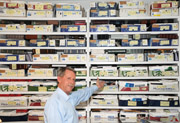
The history of gay, lesbian, bisexual, and transgendered people must not disappear like a gentle breeze that leaves no mark. Our history gives us meaning, identity, and inspiration. Sometimes it makes us happy, and sometimes it makes us sad. It offers us markers that show where we’ve been, and it gives us guideposts to tomorrow’s goals.
As a minority community, our history is sparse, and this makes its preservation even more important. Like a large tapestry, our community’s story reflects who we are and the nature of our collective character. Undoubtedly, the more threads we weave into our design, the more distinctive the tapestry becomes.
Preservationists don’t create history, but they do ensure that history survives. They know that memorial programs, hospital ID bands, test results, and empty pill bottles help us to never forget what AIDS has done to those we have loved—and that parade float designs, dinner party pictures, old choir robes, softballs, drag tiaras, and run pins reflect the vibrancy of our community’s interests and the energy with which we pursue them.
What is Our History and Where Is It?
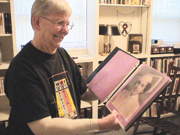
With each passing day, pieces of our community history disappear, without fanfare or concern. And yet, despite this constant loss, remnants endure because preservation-minded individuals refuse to surrender them to the ravages of circumstance and attempt to ensure that they survive. There are three major LGBT archives in Houston: The Gulf Coast Archive & Museum of GLBT History, Inc. (GCAM), the Charles Botts Collection, and the Houston Transgender Archive. OutSmart unearthed more than a dozen other collections, both private and public, and no doubt there are others.

The Gulf Coast Archive & Museum of GLBT History, Inc., is the Grand Lady of our community’s preservation efforts—for both its size and the broad spectrum of its holdings. GCAM has aggressively worked to acquire its current collection over the past 10 years. The holdings now dwarf any other local effort, filling seven large storage units, wall to wall. The organization is both an archive for documents and a museum for artifacts. Longtime curator Judy Reeves says, “If it’s GLBT-related, we want to preserve it. That includes pornography. We don’t make moral judgments. We save history as it occurred.”
GCAM has complete sets of This Week in Texas, the Montrose Voice, the Texas Triangle, and OutSmart; more than 5,000 books ranging from lesbian fiction to AIDS research; and a complete set of the Sojourner Newsletter. They have a collection of Pride Parade T-shirts, an impressive collection of drag outfits, and numerous other garments with historical significance.
Currently, the organization has a small administrative office at the GLBT Cultural Center in the Montrose Counseling Center Building, where they maintain an ever-changing historical display on the walls. GCAM regularly takes part in community events and hosts a website with a searchable database of documents and photographs.
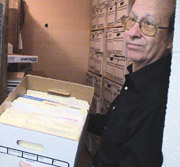
The Charles Botts Collection was begun in the 1980s. Charles Botts, its creator, had a LGBT book and document collection that outgrew his residence and found a permanent home at the Metropolitan Community Church of the Resurrection, where he worshipped. Botts died in the early 1990s and provided funding for the collection in his estate.
Today the collection houses approximately 20,000 books and row upon row of archive boxes filled with organizational files and publications. Volunteers regularly show up to catalog the holdings into a database. The organization focuses chiefly on documents and does not have storage space for historical artifacts.
The Houston Transgender Archive is in its first year of operation, housed in the Houston Transgender Center. The collection is small but highly focused, and has many rare acquisitions and an impressive presentation of their holdings. (They are the subject of a feature article elsewhere in this issue of OutSmart. )
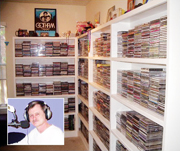
Some impressive collections are in private hands. In his home in The Woodlands, J. D. Doyle houses the largest known collection of LGBT music in the nation, with more than 6,000 LPs and CDs, as well as a large collection of digital MP3 music.
Since 1986 Dalton DeHart has been known as the LGBT event photographer. DeHart has taken more than 700,000 photographs of community activities, of which 485,000 are archived as 35mm negatives. The remaining 215,000 are digital photographs. DeHart has already donated numerous albums and boxes of loose prints to GCAM.
From 1998 to 1999, Steve Baker and Russ Byrd aired TV Montrose, a weekly commercial television program, which featured nearly 200 separate news segments about the Houston-area LGBT community. The two store the broadcast master tapes in their Spring Branch home. Among the news segments are the candlelight vigil at Rothko Chapel for Matthew Shepard and the opening of the Hollywood Motel in Galveston, which attracted considerable attention from conservative demonstrators.
OutSmart associate editor Blase DiStefano has a private collection in his home of OutSmart covers autographed
by celebrities he has interviewed. He
also has shelves of binders full of LGBT-related entertainment articles and memorabilia. ›
Bringing Preservation into the 21st Century
Despite the incredible efforts of dedicated activists, preserving our history is an overwhelming task. Since last summer, concerned individuals have begun conversations about what might be done to help organizations already in existence and to make their efforts cutting-edge state of the art. The group hopes to bring together grant writers and persons with information technology, communications and legal experience. To express both the goals and the collective nature of that work, the group has adopted the name Houston ARCH (Houston Area Rainbow Collective History).
One of those working in the group is Dr. Brian Riedel, an instructor of GLBT Studies at Rice University. He emphasizes that this group has no intention of replacing existing organizations, but rather aims to offer help where it is most needed: “ The role Houston ARCH intends to play in Houston’s GLBT community is horizontal—connecting and reinforcing the great work that existing preservation efforts are already doing.”
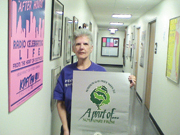
In discussing current collections, GCAM chair Craig Farrell notes, “GCAM struggles to pay the monthly rent on our seven storage units. About 20 percent of our collection is cataloged.” Riedel explains that Houston ARCH hopes to assist GCAM by searching for grant money to help the cataloging effort and to establish a permanent home for GCAM.
Botts Collection director Larry Criscione notes that, despite Herculean volunteer efforts to catalog documents, the task of digitizing the collection is enormous. Riedel hopes that Houston ARCH will find money and human resources to assist in accomplishing such an undertaking.
Houston ARCH works to strengthen collaboration between all community historical groups. Riedel is pleased that meetings to date have included representatives from GCAM, the Botts Collection, the Transgender Archive, and numerous other preservation efforts. “People are discovering many things they didn’t know about each other, and they are eagerly sharing thou ghts during networking periods,” he says.
Houston ARCH and Digitization
Recently Houston ARCH launched a website to provide a focal point for the diverse stakeholders in Houston’s LGBT history preservation. The website explains the mission and goals of the group and provides a hub of links to all the currently identified preservation efforts within the community. ›
The website was originally developed by local archivist Jo Collier and named Queerstorical Houston. That first website included sections on Houston’s gay bars, the Pride parades, a chronological history timeline, and information on past and present community publications. On the new Houston ARCH website, additional features have been added—committee work areas, discussion threads, and information on preparing oral histories.
The organizations and individuals involved plan a major focus on harnessing the power of computers, the Internet, and digitization (scanning collections into electronic format). The information technology committee is studying various possible options for storing digital media, such as photos, audio files, and video files.
Riedel points out that GCAM already has a web presence, but the Botts Collections does not. “Houston ARCH wants to help GCAM digitize its collection so that it can expand its website offerings,” he says. “There are multiple possibilities for offering a digitized Botts Collection to the greater community, depending on how the Botts Collection wishes to proceed.”
Houston ARCH and the collections are working to identify web standards for digital archiving, which will facilitate easy searching for items from diverse collections. In some cases, links will connect to existing web collections. In other cases, Houston ARCH will offer space on a collective web archive. Houston ARCH plans to take ownership responsibility for the hardware and software necessary for such a collective archive. They also hope to provide technical advice to any group or person who is not familiar with the methods of converting historical items into digital formats.
Riedel says, “When requested, we want to offer assistance with prioritizing the digitization tasks within collections and with finding the human resources for these tasks.” Houston ARCH will promote and encourage proper planning for the effects of heat, humidity, mold, insects, hurricanes, and flooding. They also plan to provide a means for oral histories to be collected and preserved.
It’s a daunting list of goals, and Houston ARCH is only in its infancy, but many talented members of the community have already come forward to offer their services. The group is in the process of gaining 501(c)(3) tax-exempt status.
The Advantages and the Perils of Electronic Preservation
With the advent of the computer age, more and more of our lives are becoming electronic. Everything from photography to rock music is now in virtual format. These new formats allow information to be easily and rapidly exchanged throughout the world. The Internet now functions as a gigantic archive and museum—without ›
the limitations of geographical location or display space. The storage area needed for virtual formats is minimal compared to the storage rooms of the past. Virtual formats allow for lightning-quick searches of large amounts of data.
Nearly everything that preserves our history can now be inexpensively transferred to digital format—home movies, 35mm slides, film negatives, photographs, records, reel-to-reel tapes, audio cassettes, video tapes, books, and correspondence. Items that can’t be digitized can be photographed and their images stored digitally. Documents scanned into digitized form become immune to the ordinary problems of preservation. They don’t fade, they don’t deteriorate, and they don’t suffer threats from mold, insects, or the weather.
But electronic storage also requires careful thought. A hard drive with data should be regularly backed up to an external storage device in case of a crash. Backups should be safely stored at an independent storage site, such as a safe deposit box. When DVDs are used for storage, “gold” DVDs should be used, not plastic. These conscientious efforts take extra care, but they ensure that information is recoverable if a disaster strikes the original computer files.
Our new virtual world also requires a new attitude toward preservation of our history. Physical boxes of paper documents force us to think what is going to be done with those papers years from now, but electronic documents don’t take up much space, so it’s going to be increasingly easy to forget about them. It will require a whole new paradigm of thought—planning for the transfer of electronic documents to preservation groups. Basically, backup drives now replace storage boxes.
Each of Us Can Help Preserve Our History
History truly starts at home. With a minimum of focused effort and the simplest of actions, we can each play an important role in the larger picture of our community history. We can sort through those boxes of things we’ve saved for years and clearly mark them for donation to a historical group. We can take care to store them in locations that are protected from the problems of climate and weather. We can add addendums to our wills specifying where the historic donation boxes and electronic backup drives are located and where they should be taken after our deaths. We can support preservation with sustaining financial assistance and leave funding in our wills. We can offer our free time as volunteers—cataloging documents, digitizing documents, writing grants, serving as organization officers, or training to become docents for exhibitions and open houses.
Business owners, professionals, and heads of nonprofits can sort through storage areas and give preservation groups non-confidential files that are no longer active. Professional services and other commercial gifts can be donated for silent auctions to benefit preservation groups. Exhibits of historical items can be hosted on commercial premises.
Organization officers can assure that prior records are kept intact during officer changes. Preservation groups can be invited to speak at member meetings, and fundraisers can be held to benefit these groups. If an organization decides to close down, an archive group can be approached to take over the custody of the group’s historic records and website content.
Perhaps the most precious and endangered history is in our individual memories. Our minds hold vast amounts of information about our pasts. At highest risk are memories from the pre-Stonewall days—before 1969, when people felt “less than.” Unless recollections are captured in written or verbal form, we take them with us when we die. Diaries and oral histories are the most priceless gifts we can offer—completely unique and one-of-a-kind.
When in Doubt, Don’t Discard It
If you’ve been saving things and wonder if they might have meaning to anyone beyond yourself, contact a local preservation group and ask for advice. Historic groups are willing and eager to review a few file folders or dozens of boxes.
For each piece of our history that is preserved, our collective story becomes fuller and more accurate. As members of the LGBT community, we each share a special challenge to leave behind a history that truly reflects who we are, rather than how our detractors wish to characterize us. As an old African proverb points out: “Until lions have their historians, tales of the hunt shall always glorify the hunters.”
Website links to organizations mentioned in this article are available online in a special section of the Houston ARCH website: www.houstonarch.pbworks.com.
Brandon Wolf also writes about Annise Parker (“Annise Parker Aims High”) and the Houston Transgender Archive for this issue of OutSmart magazine.










